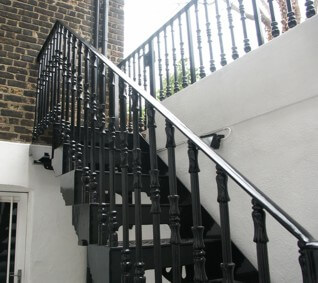Iron and Steel Fabrications Ltd design and manufacture a whole host of metalwork: from sheet metal and structural steel, to architectural metalwork and precision engineering. Up until 2008, they were using TurboCAD 2D. As they took on more and more complicated work, they decided to make the move to SOLIDWORKS and haven’t looked back. Their work can be seen in London’s prominent Gherkin, the new Barclays tower in Canary Wharf, and the prestigious Wallbrook Club in Cannon Street. They’ve also designed gantries and walkways found in Coca Cola’s state-of-the-art production facilities.
For Iron and Steel Fabrications, the benefits of SOLIDWORKS begin as early as the quoting stage when securing contracts. Sending a quote along with a 3D model of the solution to a client’s brief ensures that both parties understand what is to be delivered. As opposed to 2D drawings, a photorealistic rendering in situ from SOLIDWORKS instantly puts both parties on the same page. This practice instils confidence, speeds up sales cycles, and has helped the company secure some large contracts. They communicate this data largely through eDrawings and 3D PDFs – this allows any client to view, manipulate, and investigate 3D models to gain a better understanding of designs. Sending 2D drawings in SOLIDWORKS is as easy – in SOLIDWORKS, Iron and Steel Fabrications automatically create full technical drawings as a by-product of their SOLIDWORKS data.

Designing sheet metal products in SOLIDWORKS is substantially quicker and more accurate than designing in 2D. In SOLIDWORKS, a sheet metal product can be designed as a complete product, just as it would look when manufactured. With the click of a button, Iron and Steel Fabrications can produce a sheet metal flat pattern that gives the exact dimensions required to manufacture the completed product. This has almost eliminated material waste and reworking when it comes to manufacturing sheet metal products.
Designing in 3D has improved drafting quality and accuracy across the board. Occasional conflicts and inconsistencies experienced when designing in multiple dimensions in 2D are long gone in SOLIDWORKS. Its parametric capabilities also mean that when they change a dimension, all associative dimensions are updated. “This isn’t such a big problem for simple product design, but we’re taking on more complicated jobs now, so this saves time and vastly improves the accuracy of our work.”, said Julian Carter, Managing Director of Iron and Steel Fabrications.
Iron and Steel Fabrications have used other 3D CAD systems in the past, but found them so cumbersome and unintuitive that designing was even slower than working in 2D. “The drawing capabilities in SOLIDWORKS makes initial conceptualisation much quicker, to the extent that our design times have been slashed by around 60%. Not only that, our designers really enjoy using SOLIDWORKS”, said Julian Carter.
Before implementing SOLIDWORKS, Iron and Steel Fabrications took on a project that involved producing a structural base frame for a prestigious building. Years later, the company was asked to help design an extension to the building. In SOLIDWORKS, Julian and his team have found the job much easier. He said: “The initial job involved 3 weeks of drawing. This time around, the job took no more than a week.” This direct comparison is real proof that SOLIDWORKS has delivered a tangible return for Iron and Steel Fabrications.
The superior customer service that Iron and Steel Fabrications offer is partly thanks to the way they utilise SOLIDWORKS. Many of the company’s competitors are still using 2D CAD and can only rely on the produced drawings to a certain extent. Unlike other metal fabrication companies, Iron and Steel Fabrications go the extra mile to ensure that when they arrive on site to install, everything will fit and assemble first time without on-site modifications. SOLIDWORKS is a big part of this process, and not only improves customer service, but saves the man-hours and materials that would be wasted due to rework.
Take a look at other companies using SOLIDWORKS in the construction industry


















